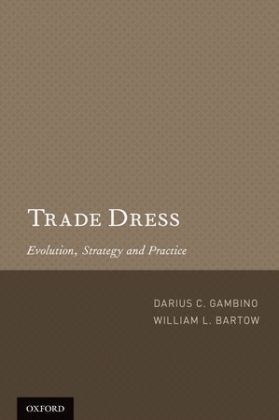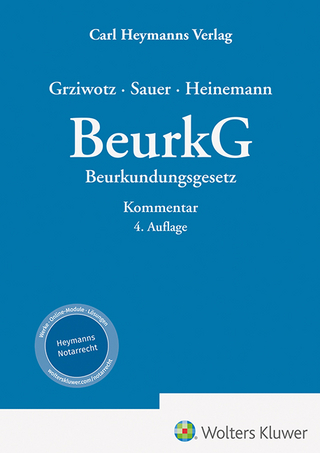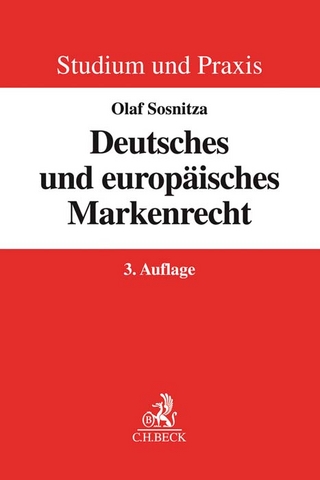
Trade Dress
Oxford University Press Inc (Verlag)
978-0-19-984066-3 (ISBN)
- Titel ist leider vergriffen;
keine Neuauflage - Artikel merken
While the concept of trade dress has existed for some time, the doctrine remained dormant for many years until the Supreme Court decisions in Two Pesos, Wal-Mart and TrafFix Devices. These decisions raised the profile of trade dress, and changed its perception for many practitioners. Ultimately, these decisions increased attention to trade dress at the developmental stage. As with patents, many companies have implemented programs to identify and protect trade dress as early as possible, especially in the wake of these decisions. There is no doubt that trade dress litigation will soon not only become a major competitor to patent litigation as a means of resolving disputes, but in most instances, a significantly cheaper and viable alternative. Trade Dress: Evolution, Strategy, and Practice analyzes the differences between the two major types of trade dress - product configuration and product packaging - describes the standards of proof for each, and explains how these standards have been interpreted (and in some cases misinterpreted) by the federal courts. The book also reviews the evolution of trade dress in the United States and its recent emergence as an enforcement alternative.
Finally, it offers practical suggestions on how best to utilize trade dress rights in protecting a client's intellectual property.
Darius C. Gambino is a partner in the Intellectual Property Department of DLA Piper U.S. LLP. He focuses his practice in the areas of patent prosecution and litigation (mechanical, business method and electrical arts), trademark registration and enforcement, corporate transactions and due diligence, copyright registration and enforcement, trade secrets, licensing, opinions. William L. Bartow is senior associate in the Intellectual Property Department of DLA Piper U.S. LLP. He focuses his practice in the areas of patent prosecution and litigation (mechanical, business method and electrical arts), trademark registration and enforcement, corporate transactions and due diligence, copyright registration and enforcement, trade secrets, licensing and opinions.
ACKNOWLEDGMENTS ; FOREWORD ; CHAPTER 1 THE ROOTS OF TRADE DRESS ; A. INTRODUCTION ; B. THE TRADEMARK ACTS OF 1870 AND 1881 ; C. THE TRADEMARK ACT OF 1905 ; D. THE TRADEMARK ACT OF 1946 - THE LANHAM ACT ; E. THE LANHAM ACT AMENDMENTS OF 1988 AND 1999 ; F. THE MODERN DAY SUPREME COURT DECISIONS ; CHAPTER 2 PRODUCT CONFIGURATION VS. PRODUCT PACKAGING VS. PRODUCT COLOR ; A. PRODUCT CONFIGURATION ; B. PRODUCT PACKAGING ; 1. DECOR ; 2. THE OVERALL LOOK AND FEEL OF PACKAGING ; 3. COLORS ; 4. SOUNDS ; 5. SCENTS TEXTURES & FLAVORS ; 6. BUSINESS TECHNIQUES ; C. PRODUCT COLOR ; D. FINAL THOUGHTS ; CHAPTER 3 TRADE DRESS PROTECTION AND ENFORCEMENT PRIOR TO 1992 ; A. EXAMPLE CASE 1: TIME, INC. V. GLOBE COMMUNICATIONS CORP. (SDNY 1989) ; B. EXAMPLE CASE 2: FUDDRUCKERS INC. V. DOC'S B.R. OTHERS, INC. (9TH CIR. 1987) ; C. EXAMPLE CASE 3: READER'S DIGEST ASSOC. INC. V. CONSERVATIVE DIGEST, INC. (D.C. CIR. 1987) ; D. THE FUNCTIONALITY DOCTRINE PRIOR TO 1992 ; E. SECONDARY MEANING PRIOR TO 1992 ; F. LIKELIHOOD OF CONFUSION PRIOR TO 1992 ; G. REMEDIES PRIOR TO 1992 ; H. CONCLUSIONS ; CHAPTER 4 THE RECOGNITION OF TRADE DRESS - TWO PESOS ; A. INTRODUCTION ; B. INHERENT DISTINCTIVENESS PRIOR TO TWO PESOS ; C. THE TWO PESOS CASE ; D. TWO PESOS AT THE SUPREME COURT ; E. THE IMPACT OF TWO PESOS ; CHAPTER 5 WAL-MART & TRAFFIX ; A. THE WAL-MART DECISION AND INHERENT DISTINCTIVENESS ; B. TRAFFIX AND FUNCTIONALITY ; CHAPTER 6 LIVING IN A POST-TRAFFIX WORLD ; A. SIGNIFICANT POST-TRAFFIX FUNCTIONALITY DECISIONS ; 1. FEDERAL CIRCUIT - VALU ENGINEERING AND THE MORTON-NORWICH FACTORS ; 2. THIRD CIRCUIT - SHIRE AND THE PRIMARY/SECONDARY TEST ; 3. SIXTH CIRCUIT - FUJI KOGYO AND THE UTILITY PATENT PRESUMPTION ; 4. CONCLUSIONS ; B. KEY DECISIONS ON INHERENT DISTINCTIVENESS AFTER WAL-MART ; 1. YANKEE CANDLE - FIRST CIRCUIT ; 2. HARTCO ENGINEERING - FEDERAL CIRCUIT ; 3. CONCLUSIONS ; CHAPTER 7 COMPARISON TO OTHER TYPES OF INTELLECTUAL PROPERTY ; A. INTRODUCTION ; B. TRADE DRESS RIGHTS ; C. DESIGN PATENTS ; D. UTILITY PATENTS ; E. COPYRIGHTS ; F. THE RIGHT TO COPY DOCTRINE ; CHAPTER 8 THE APPLE COMPUTER EXAMPLE AND THE IP TRIFECTA ; A. HOW APPLE PROTECTS INTELLECTUAL PROPERTY ; 1. OVERALL STRATEGY ; 2. APPLE'S TRADE DRESS ; 3. MARKETING/ADVERTISING ; 4. INTELLECTUAL PROPERTY REGISTRATION ; 5. ENFORCEMENT ; B. CONSIDERING THE IP TRIFECTA ; C. IMPLEMENTING THE IP TRIFECTA ; D. CONCLUSIONS ; CHAPTER 9 REGISTERING AND ENFORCING TRADE DRESS ; A. REGISTERING TRADE DRESS WITH THE UNITED STATES PATENT AND TRADEMARK OFFICE ; 1. ADVANTAGES OF REGISTRATION ; 2. REQUIREMENTS FOR A TRADE DRESS APPLICATION ; 3. USPTO EXAMINATION PROCESS ; 4. TRADE DRESS SPECIFIC REQUIREMENTS FOR REGISTRATION ; 5. EXAMPLES OF REGISTERED TRADE DRESS ; B. ENFORCING TRADE DRESS THROUGH LITIGATION ; 1. THE FEDERAL CIRCUIT (THE DUPONT FACTORS) ; 2. THE FIRST CIRCUIT (THE PIGNONS FACTORS) ; 3. THE SECOND CIRCUIT (THE POLAROID FACTORS) ; 4. THE THIRD CIRCUIT (THE LAPP FACTORS) ; 5. THE FOURTH CIRCUIT ; 6. THE FIFTH CIRCUIT ; 7. THE SIXTH CIRCUIT ; 8. THE SEVENTH CIRCUIT ; 9. THE EIGHTH CIRCUIT (THE SQUIRTCO FACTORS) ; 10. THE NINTH CIRCUIT (THE SLEEKCRAFT FACTORS) ; 11. THE TENTH CIRCUIT ; 12. THE ELEVENTH CIRCUIT ; 13. THE D.C. CIRCUIT (THE POLAROID FACTORS) ; C. EXEMPLARY LIKELIHOOD OF CONFUSION CASES ; D. EXEMPLARY LIKELIHOOD OF DILUTION CASES ; CHAPTER 10 TRADE DRESS REMEDIES ; A. INJUNCTIONS ; 1. PRELIMINARY INJUNCTIONS ; 2. PERMANENT INJUNCTIONS ; 3. INJUNCTIONS REQUIRING CORRECTIVE ACTIONS ; 4. THE IMPACT OF EBAY ; B. DISGORGEMENT OF DEFENDANT'S PROFITS ; C. RECOVERY OF PLAINTIFF'S ACTUAL DAMAGES ; D. THE COSTS OF THE ACTION ; E. CORRECTIVE ADVERTISING ; F. TREBLE DAMAGES AND ATTORNEYS' FEES ; G. FINAL THOUGHTS ON INJUNCTIONS AND DAMAGES ; CHAPTER 11 DEFENSES TO TRADE DRESS INFRINGEMENT ; A. FUNCTIONALITY ; 1. UTILITARIAN FUNCTIONALITY ; 2. AESTHETIC FUNCTIONALITY ; B. LACK OF DISTINCTIVENESS ; 1. INHERENT DISTINCTIVENESS ; 2. ACQUIRED DISTINCTIVENESS (SECONDARY MEANING) ; C. NO LIKELIHOOD OF CONFUSION ; D. GENERICNESS ; CHAPTER 12 THE FUTURE OF TRADE DRESS ; A. INTRODUCTION ; B. RECENT COMPLAINTS INVOLVING TRADE DRESS ; C. THE FUTURE OF UTILITARIAN FUNCTIONALITY ; D. THE FUTURE OF AESTHETIC FUNCTIONALITY ; E. THE FUTURE OF MONETARY DAMAGES ; F. CONCLUSION ; TABLE OF CASES ; INDEX
| Zusatzinfo | Illustrations |
|---|---|
| Verlagsort | New York |
| Sprache | englisch |
| Maße | 156 x 235 mm |
| Gewicht | 438 g |
| Themenwelt | Recht / Steuern ► EU / Internationales Recht |
| Recht / Steuern ► Wirtschaftsrecht ► Urheberrecht | |
| ISBN-10 | 0-19-984066-0 / 0199840660 |
| ISBN-13 | 978-0-19-984066-3 / 9780199840663 |
| Zustand | Neuware |
| Haben Sie eine Frage zum Produkt? |
aus dem Bereich


